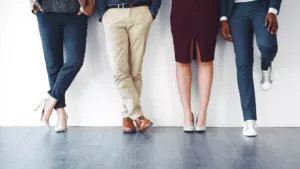Hi there and welcome to the series that focuses on leg gestures and signs.
I’m quite sure you came here asking yourself: “How much can you really learn about someone from the way he points or moves his legs? Well apparently plenty, because otherwise, I wouldn’t mention it, right?
Here we will learn how to pay attention to the body language of legs; signs that are often overlooked even by the keen observer. But first let me try to convince you that this is worth your time:
** A quick but important note: In the first 2 parts I will focus on the standing leg positions, the sitting positions are here, don’t confuse them.
Why are the Legs so Important?
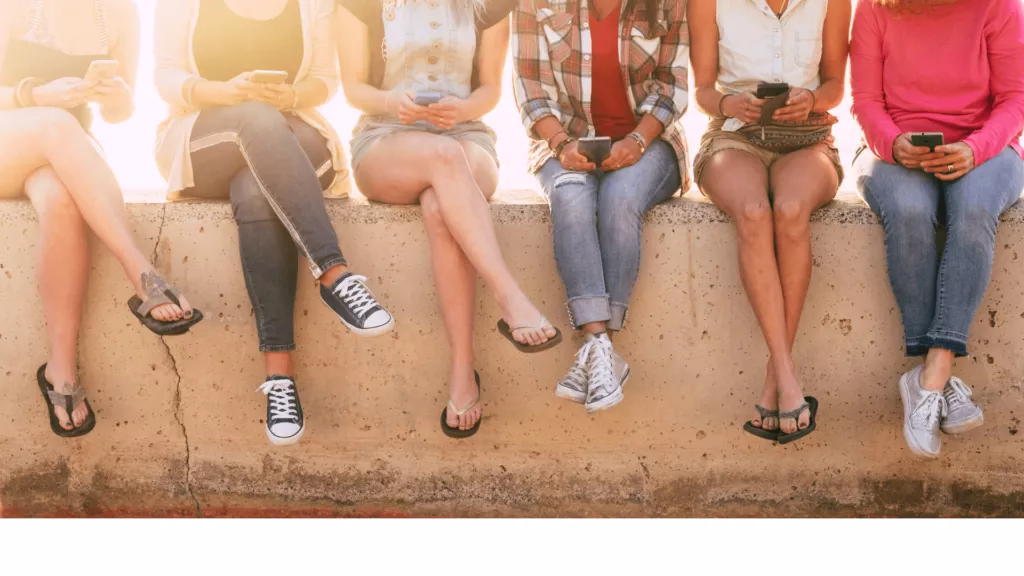
When I first started to learn body language I didn’t think there was much to pick up from the legs. Honestly, when was the last time you observed what someone did with his legs? It’s much more intuitive to remember faces or a particular movement rather than the way someone stands. So what’s so special about the body language of legs?
In short – they’re honest, very honest.
Here in Israel, we have a saying that says: “Far from the eye – far from the heart” Meaning that things that are far away are not in imminent concern. This is a literal explanation of why most of us may lie with words, wear false smiles or deceive with hands, but rarely care about what the legs “say”.
The legs are the farthest limbs away from the brain – and therefore far from the attention of others. Because we never truly care or focus on what others do with them, we also tend to neglect what we do with ours. This neglect leaves a lot of room for the keen observer to notice hidden thoughts and attitudes that are not clearly visible anywhere else in the body.
This is in contrast to the face, for example; Because the face is the center of attention when interacting with others and can easily “leak” emotions – we quickly learn to manipulate it to wear the mask we need.
Now that we know that, let’s see what we can decipher from the body language of the legs:
How Stable Are You?
A lot can be said about someone by the way the person stands. There is a correlation between how stable one’s stance is to his self-confidence and well-being.
Having a balanced weighted stance on both legs with the legs wide apart is an aggressive and dominant position. Just imagine a gunslinger standing ready during a showdown.
Planting both feet in front of someone can be quite intimidating because it leaves no room to maneuver around it.
It’s either a hostile attitude if both are of the same sex, or a signal of attraction and interest when they’re of the opposite gender.
Alternatively, standing with both feet close to each other is a signal of submission, recognition (soldier’s attention stance), or uncertainty. It’s really easy to push over a person in this position, both physically and socially.

It’s also makes you a smaller target and that’s why it often adopted by timid and introverted people who wish to avoid being noticed.
Standing with the weight on one foot while the other points aside is usually a more relaxed position, and it may tell about some opinions and desires of that person (which I’ll elaborate on more later).
Crossed Legged Positions

Crossing legs is very similar to folding arms. It covers the genital area and can hint at a guarded mindset. While they are similar, crossing the legs is a much less self-conscious act, and doesn’t always carry negative connotations.
Crossing the legs immobilizes us – we cannot move until we uncross them. So it can be a negative sign – where it’s an outcome of a reserved and suspicious mood; you’re not willing to go further or change your mind. Crossed legs are also a known sign of a “nature call”, don’t confuse “need to pee” with “you didn’t convince me”.
On the other hand, it can be a simple laid-back position – in relaxed encounters, many people adopt this posture to show they’re tied up with the current interaction, they don’t have intentions of leaving. Just keep in mind that it’s passive, so don’t use this stance when you need to influence or convince others, you won’t seem serious and motivated enough to urge others.
Pointing with the Legs
The feet, just like other body parts, can hint to us about the desires of a person and his center of attention. You can often guess where one wants to go, and how urgently, simply by looking at the direction he points his feet.
For example, suppose you observe that the person you’re talking to stands both feet away from you, it’s a good sign that he/she is not interested in interacting with you right now and probably wishes to leave.

The feet are more reliable indicators of such desires than other hints from the body because yet again, they’re “invisible” to another’s gaze and attention. We might be smiling and nodding, but we don’t really think about the direction of our bodies.
Pointing is an especially useful signal during group interactions; when a group stands in half or full circle – you can easily identify where the participant’s attention is directed by looking at their feet.
How can Feet Position tell you when to enter a Group Conversation?
If you’re trying to enter an ongoing conversation it’s worth checking if their feet point towards one another or if some are facing outside.
If it’s a closed group in a very active conversation, their feet will form a closed circle – they are not welcoming external intrusion.
If on the other hand, you’ll notice people’s feet pointing outside “the circle” – they are more welcome to external company and interruption, and it’s best to approach the group from that “open” side.
What is the Stork Position and What Does it Mean?
Standing on one foot while tucking the other behind her around the calf, resembling a stork, is almost an exclusively female gesture that reveals inhibition and a conservative attitude.

Since we talked about the stability of stance, you can note that this posture is probably one of the least stable – even the lightest breeze can topple this poor girl off.
So, in order to “break the ice” with such a girl a careful and attentive approach is required, just like approaching a frightful animal, you don’t want to frighten and let herself close even more.
Why it’s a female gesture?
Probably because it’s an uncomfortable stance for men to mimic due to their lack of flexibility.
But don’t worry, men have their own share of defensive signals, which we’ll discuss later.
Don’t confuse the “stork stance” to a similar but comfortable habit; where one foot is resting beside the other leg, not behind her.
Why that happens?
Simply because some people prefer to balance themselves on one foot on informal occasions, that’s all. You can say it’s part of their “standing style”
What about Legs and Feet in Motion?
Let’s talk about some examples of dynamic leg movements:
What are Happy Feet?
When we feel good, excited, or positive towards current events we often let that excitement show through the way we move our body; happy people walk with jumpy strides, as if they’re about to lift off from the ground. So even when we sit idle or when we try to conceal our excitement – we still reveal it through our feet – we rock back and forth on our heels with buzzing anticipation.
What does Stomping Feet Mean?
Stomping the feet is one universal sign of a hostile attitude or frustration. In the animal kingdom the bull stomps his hoof as he prepares to ride down his target. In humans it simply shows that something is gone amiss, so we express that anger in a physical way.
Yet, it’s a child-like gesture, so it’s quite curious when it happens in adults – they either let their feelings overwhelm them or are very expressive.
The Meaning of Foot Tapping
Tapping one foot rapidly on the ground is one annoying habit… which I admittedly possess. I’m very familiar with the symptom because it occurs to me when I’m impatient or bored. This jerky leg movement helps me release some excess energy from my boredom or nervousness, but in turn, antagonizes others around me. Lucky for me and others, it’s possible to break this habit, just like nail biters can stop chopping their nails; it simply requires conscious effort and diligence.
There may be other variations to foot tapping that reveal tension – they all possess the annoying attribute of being rapid and shaky, the faster the rate – the more agitation there is.
An interesting note however – as the tension or boredom fades, the leg movements turn to be slower and more relaxed, so it’s a good barometer of someone’s level of unrest.
Sitting Positions
We often can get a lot more info from seated variations of leg positions than from standing ones simply because when we sit our legs are quite useless – we don’t have anything specific to do with them; and these are the exact moments when we can easily identify all sorts of temperaments, when the legs have nothing else to do but to leak nonverbal information.
Alright, let’s start with:
What are the Indications of Interest?
The first group of sitting leg gestures I want to mention are the Indicators of interest.
I already talked about pointing with feet in the previous articles so I only mention it again to note that it applies to sitting positions as well.
In sitting scenarios, it’s even more obvious, as anyone who ever got stuck at the end of the sofa alone can tell.
Another form of orienting when seated comes in the shape of the knee point – when one leg is folded under the other and the knee marks the direction of attention.
Don’t forget learning – it’s the most direct way to show interest or lack of it.
Men – Exposing the Crotch

When we talk about sexual interest, expressive men have the “crotch display” – sitting with the legs wide apart to signal virility and availability. These men usually signal that they feel dominant, strong, and even a little smug – this position takes a lot of space and exposes their groin for the whole world to see. Needless to say, it can easily offend others (or on the contrary – entice them) So while it’s good to show confidence, if you don’t want to annoy anyone – mind the distance between your knees.
Women – Shoe play

Females have something a bit more sophisticated – the shoe play: While the shoe dangles off their foot, they remove and enter their foot back and forth into it. Such display can drive men crazy because it reminds them of the repeated action during intercourse.
Leg over Leg Meaning
Crossing one leg over the other is a very popular way of sitting and has many variations. Women, for example, prefer the tight leg cross to emphasize their leg features. Men often use the 4 figure sitting cross-leg position.

The leg-over-leg “standard position” is usually done with the dominant leg on top.
While crossing the legs may indicate a closed and reserved attitude, it’s not always so. It has a lot to do with habit and comfort. In an uncomfortable chair with no armrests, it might be more convenient to sit in a crossed position and lay the hands on the thighs.
For completely another reason, we adopt the crossed sitting position when we’re cold.
Women have more trouble than men sitting in uncrossed positions mainly because their clothing often doesn’t allow that (mini-skirts) or because it’s an established habit.
What is the Leg Stretch Position?

A very sexual display with the legs females utilize extremely effectively is the leg stretch.
Sitting with one leg crossed over the other stretches the muscles and reveals smooth sexy legs. Women can easily use this flirting gesture to draw attention, especially if she’s crossing and uncrossing them frequently (like in the famous scene of Sharon Stone in” Basic Instinct” for example)
The 4-Figure Position

The 4 figure sitting position involves resting one foot over the thigh of the other, and it’s usually much more comfortable for men than the tight leg cross.
It’s a popular male leg cross, although it can be seen in some assertive and extrovert women too.
In an unconscious manner it exposes the genitals and takes more space – a confident, self-assured, and even cocky posture. It’s also a way to show a competitive and challenging attitude toward others, as if to say “I’m not impressed, try harder”
Sitting with Both Feet on the Ground

Placing both feet on the ground with a “standard” gap between them is the most basic, normal position you can think of. Just like with hands-to-the-sides posture it serves as a neutral but powerful starting point. It’s stable, focused, and lacks any other nonverbal “noise” – so it’s very effective for formal and focused conversations.
I must add that placing both feet on the ground is much less common for females, who prefer the crossed-leg position, either because they wear skirts or because they are socially taught to sit that way.
Tension and Readiness to Action
Tension can wear many forms in body language, and it’s easily exposed when we sit. When we sit we’re idle get lost in our thoughts and then our negative thoughts leak through unconscious motions. Some notable examples:
What Locking Ankles Means
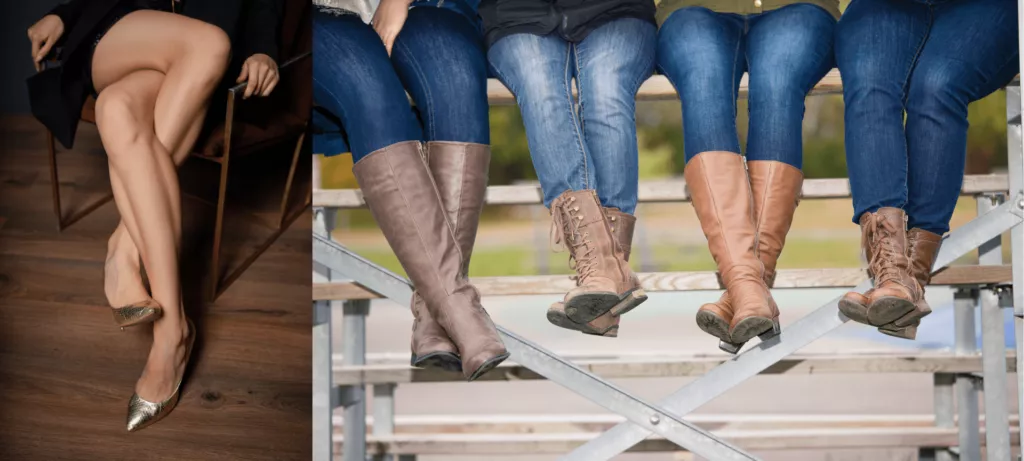
Entwining the ankles is usually a signal of self-restraint; It’s similar to biting the lip, holding oneself from slipping another word. It can hide emotions of anger, frustration, fear, or other negative emotion.
Men will usually lock their ankles beneath the chair and their hands will clamp into fists or grab tightly the armchairs.
Females will usually close both legs and turn them to the side while their hands rest on their knees or to their side.
- Wrapping legs around the chair legs
- The Clasp
To reinforce his position, the guarded person will not only cross his legs but will also clasp his hands around them. Like a clamp – there’s no way he’s going to open up easily. It’s a very common posture to observe in subways where strangers sit in front of each other.
Keeping the knees together
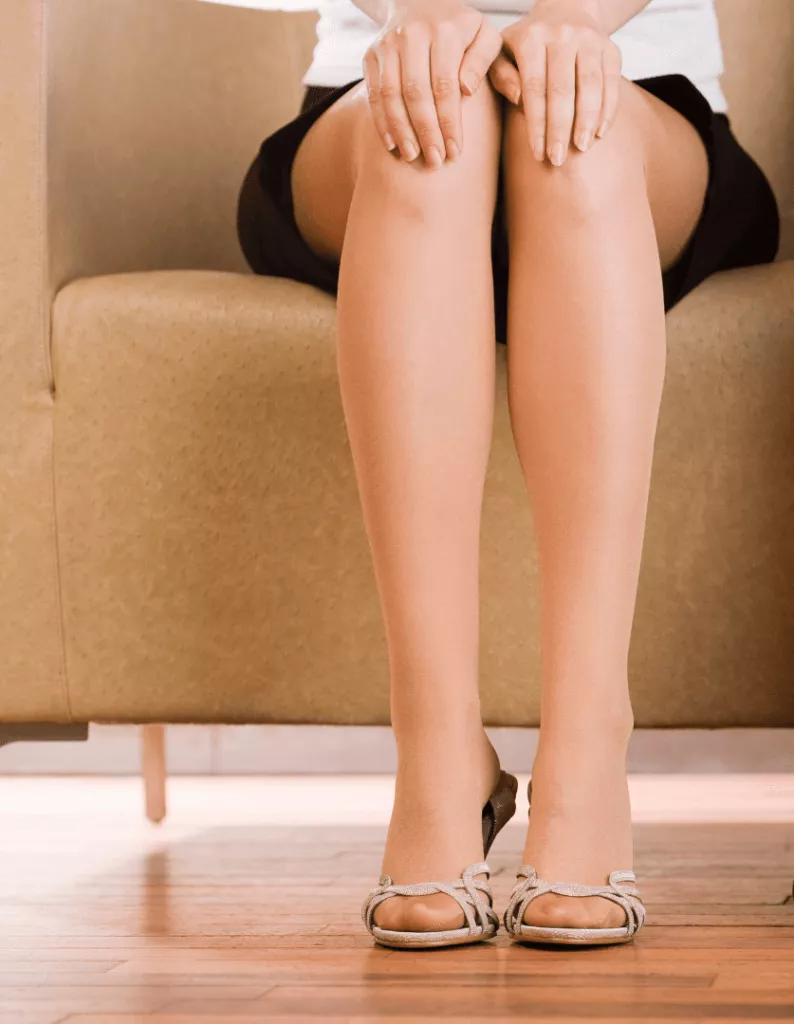
This one is a tricky one, because while it can show a reserved and timid mindset, many females are taught to sit this way for obvious reasons (skirts) and stick to this habit throughout their lives. But men have no excuse for using such a display – and it’s quite rare to observe such an obvious display of insecurity.
Covering Genitals
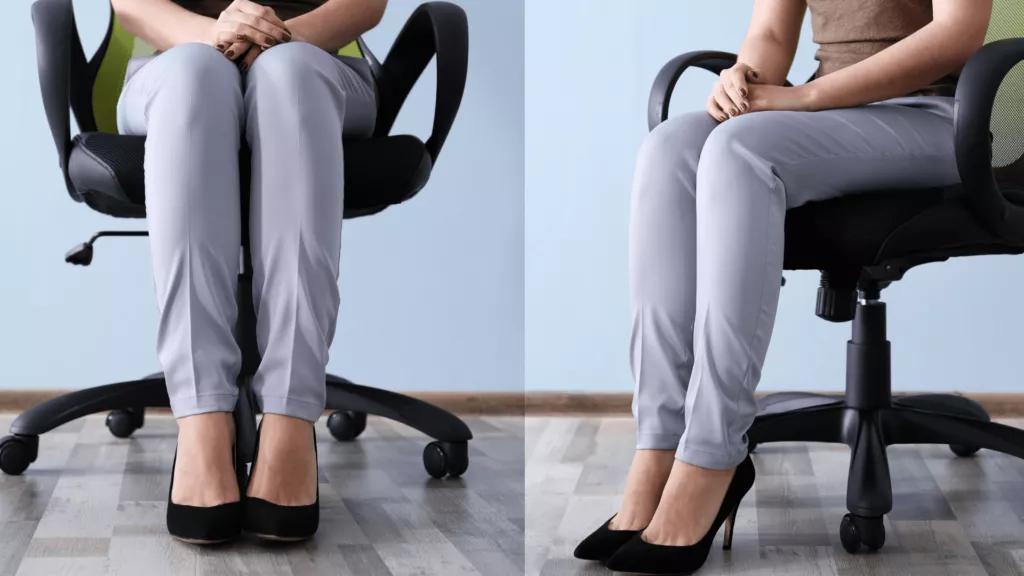
Covering the crotch can be done by holding the legs tight and crossing the hands over it.
Just like spreading the legs yells “Look at me! I’m here! I’m fertile and powerful” so covering the same area sends the opposite message “I’m unsure, tiny and timid, please don’t hurt me.”
Just like Adam and Eve had left to cover their gentiles when they felt ashamed – we mimic such behavior even when we’re fully clothed. Again, this gesture applies more to men, because females, in general, avoid touching or resting their hands around their crotch.
How to tell if someone is relaxed

In informal relaxed circumstances, the variations of different leg positions is huge, after all it is informal – anyone can sit however he wants. Most informal positions have the tendency to be spread out and take strange forms. Placing the feet on a table is the ultimate “feel good” posture – What’s more relaxed than spreading the legs up, putting the hands behind the head, and enjoying life, right?
Sitting on the floor

I won’t go into detail on each form, because their meanings are quite the same – they all tend to be as relaxed and comfortable as possible.
I do want to mention the leg spread forward because it can really affront certain people due to its idle image. Serious and sensitive situations require attention and readiness, so this lazy posture is a signal that whatever happening isn’t important or interesting enough for the person who adopts it.
The eastern sitting posture is much more suited for such cases. Instead, adopt the “eastern sitting” – sitting on folded legs. It’s still informal but shows more involvement than the previous one.

